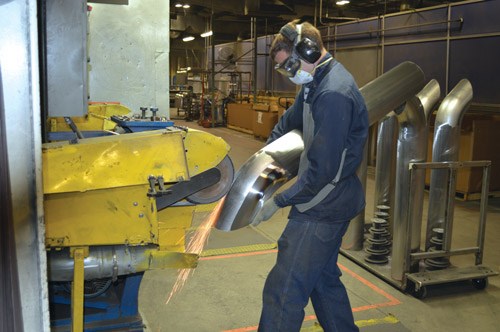Top Shops: Innovation makes Lincoln Industries a 2016 Top Shop
Nebraska finisher grows with help of an innovation team to identify new technologies to solve customer problems.
#topshops
The U.S. map that Marc LeBaron saw in 1992 did not lie. The map showed his company, Lincoln Industries, smack in the middle of the country, and not anywhere near the customers he needed to be close to in order to grow his finishing business.
“You could draw a 200-mile circle around us without seeing much manufacturing located close,” LeBaron says. “It was clear we needed to have something extra special to offer people to come to us.”
Featured Content
It was in the early 1990s that LeBaron was coming off the chairmanship of the National Association of Metal Finishers (NAMF). He had spent the past year visiting over 100 plants in the U.S. as part of his NAMF responsibilities, and what he saw was many good electroplating shops, but not many that were a major player in the plating world.
“There weren’t that many shops that broke through that ‘small company’ level and really grew as an entity,” he says. “And with us being in Nebraska, it would make it even tougher to grow as much as we wanted to. If we didn’t change our thinking, we would be just another electroplater and another job shop.”
In 1952, his father, Dale LeBaron, started Lincoln Plating in Nebraska as a small custom shop for local manufacturers, specializing in made-to-order solutions for a relatively few number of customers, but steadily grew the shop as a regional business that was doing fairly well.
After Marc took his whirlwind tour more than 25 years ago and saw an opportunity to become a national player by offering more services and expertise to large OEMs, Lincoln began to drastically change.

Lincoln CEO Marc LeBaron (right) and President Tom Hance have led the company into developing more innovative coating processes for its customers.
New Approach
“We really took a step back and started looking at the world a little differently,” says LeBaron, who by then had purchased Lincoln from his father. “We simply asked ourselves, ‘How can we create more value for the customer outside of just finishing?’ It was then that we took a bigger view of what we could do to get more business.”
LeBaron gives an example of a part manufacturer who must find a raw material supplier, a diemaker, a stamper, a polisher and a finisher to get the part completed. Where Lincoln was filling the last spot in the chain, LeBaron saw his company managing the entire process for the manufacturer.
“Our thought process was that we would spend 10 cents more per piece on material and get a semi-finished part,” he says. “And I will find a stamper who, instead of sending the parts tumbling down the chute where it will get nicked and dinged, I’ll have him hand stack it in foam and then we’ll finish the product here. We will spend 60 cents more, but we can charge the customer $2 less because we don’t have as much polishing or repair work.”
It was the approach to provide more value to manufacturers and optimize the supply chain that caused Lincoln to explode in the 1990s into one of the largest plating operations in the world, if not the largest in North America, according to the company, with a robust 27 plating lines and dozens of polishing and buffing stations.
Though Lincoln once only provided plating, polishing, supply chain management and customer service to its customers, it now offers fabrication and manufacturing, engineering and design support, supply chain management, assembly, packaging, warehousing and logistics management. The company also changed its name from Lincoln Plating to Lincoln Industries to reflect its change
in approach.
That gives Lincoln the benefit of guiding customers throughout a product’s entire life cycle, thus streamlining the supply chain to optimize performance and efficiency for the OEM.
Big and Bold
That paradigm change in thinking almost 25 years ago is what has made Lincoln one of the largest—and certainly one of the most efficient—electroplating, polishing and buffing operations in North America, serving as a Tier-One supplier to many of the largest manufacturers.
“We compete on value,” says Clint Boothe, who handles the top strategic accounts for Lincoln. “Most of the supply chain that gets done for automotive—because of the sheer volume—very quickly becomes a commodity. Our strategy has been to not chase those type of projects. We want to bring more to the table than just volume.”
Besides LeBaron’s change in approach 20 years ago, the most recent advancement came when former Lincoln president Hank Orme announced his retirement from the company in 2012. LeBaron knew he needed to replace Orme with someone that would take Lincoln into the next realm of “value-added” services that Tier-One suppliers required.
If LeBaron was looking for someone who could keep tight reins on a company and ride out the bucking and kicking of a wild world economy, he found the perfect guy in Tom Hance, who is also still an active rodeo competitor and a member of the Professional Rodeo Cowboys Association.
Hance took over as president of the company after a career at General Electric, A.B. Electrolux/Frigidaire, Desco, Lozier and eventually Northstar, a privately held restaurant company and his last stop before heading to Nebraska.
One of the first directives from the new president to the Lincoln team was to find out the customer’s needs, and then give it to them.
“In the past, we had focused on products and services,” Hance says. “Certainly, finishing services for technically difficult products will always be a large part of what we do to serve our customers. More importantly, our success is tied to our ability to use technology that provides solutions to our customers and for their customers’ needs.”

The new lines have several features that set it apart from the company’s existing nickel chrome lines, including deeper tanks to vertically process larger exhausts.
Pivoting
Hance calls the approach “pivoting,” meaning Lincoln does not deviate from its core functions of surface finishing, but the additional services and value-added capabilities build on the relationship they have with their customers, including Daimler, Harley-Davidson, John Deere, Mercury Marine, Polaris and many more.
The result of that “think differently” mentality was the development of the company’s innovation team in 2013, a group of people from different skill sets—engineering, operations and technology—who have the responsibility of identifying new technologies that would solve customer problems, as well as identifying new ways to serve Lincoln’s customers.
The team of about a dozen people are housed together in one building at the sprawling Lincoln Industries campus, giving them an opportunity to talk frequently and meet often to come up with solutions and possibly develop new products, which is what happened when the innovation team developed a high-temperature thermal insulation coating, which it calls ThermoLinc Genesis.
Two years in the making, ThermoLinc Genesis is designed for vehicular exhaust systems where keeping heat or protecting nearby components from heat is important. Almost two years in the works by the innovation team, the coating uses a moisture-activated resin chemistry that forms into a glass matrix, which includes a large amount of insulating materials and other ingredients that help performance and result in a tough, durable, low thermal conductivity coating.
While the innovation team is fairly new, the concept of coming up with newer and better coating applications is not, says Chad Nadgwick, a senior innovation engineer on the team.
“Our greatest success comes when our team collaborates with our customers,” he says. “We hold technical summits that enable us to make sure we are doing things that make sense for the challenges our customers are facing. In the end, what we do must benefit the customer, and our summits provide a gut check for us to align our development with them.”

Lincoln’s innovation team is coming up with newer and better coating applications for its customers.
Tube Acquisition
Part of the innovation progression was the acquisition of DS Manufacturing, a Minnesota-based company specializing in small-diameter tube fabrication for all-terrain vehicles and lawn equipment. Hance says the acquisition strengthens Lincoln’s evolution as the the leading supplier of exhaust tubes since they are already the supplier of tubes to each of the four leading over-the-road truck companies.
“The acquisition accelerates the development of integrated capabilities for our technology and builds on our strategic investments to date,” he says. “It positions us to deliver ongoing growth by increasing our product portfolio and expanding our market opportunities.”

Lincoln has one of the largest finishing operations in North America.
Boothe says DS Manufacturing brings a lot of added value to the Lincoln stable.
“We sell chrome-plated parts to the motorcycle industry such as decorative covers, heat shields and light housings,” he says. “We didn’t have a presence in bent, polished and plated tube. Engine guards, luggage racks and handle bars would be examples. DS gives us an opportunity in an area in which we don’t have a presence, and that’s very exciting for us and our customers.”
But Hance is quick to remind everyone about the ‘pivot.’ He says Lincoln is still a plating and polishing operation at its core, which explains the expansion of the plant in 2015 to build its largest nickel chrome line.
“It comes at a time when we further strengthen our position as a major manufacturer in the heavy-duty exhaust market,” Hance says.
Dean Rabel, Lincoln’s senior plant engineer, says the new line has several features that set it apart from the company’s existing nickel chrome lines, including deeper tanks to vertically process larger exhausts, which they say will improve both quality and productivity.
“We have also increased the number of tanks, giving us the opportunity to add a trivalent chrome process in the future,” Rabel says. “This is our first nickel chrome line with dual chrome capabilities. We have 16 individual rectifiers installed for each plating cell, which means we can set currents to each load resulting in increased flexibility and further quality improvements.”
The new line has four hoists, which is one more than the other automated lines. It also has unique loading and unloading equipment installed to accommodate operators who need to reach the highest part on the flight racks. The parts are lowered into the floor so the highest parts on the racks can be reached.
Rabel says the new line also has special environmental features, including a rinse water conservation system. Instead of a continuous metered flow of water, the new line has intermittent flow based on the size of the load, which will result in a 25-percent water savings.

Lincoln's quality control team meets regularly to solve production issues.
Best Company to Work For
All of this growth pleases LeBaron, who not only runs his company in the way his father would want it run, but is almost idolized by the more than 600 employees, who recognize his genuine concern for their safety and well-being.
In fact, Lincoln Industries is annually recognized as one of the top companies to work for, not just in Nebraska, but in the U.S.
“For the first 50 years, metal finishing represented 90 percent of the company’s sales,” LeBaron says. “Now we are a diversified manufacturer of many products that serve many industries.”
Hance says transforming Lincoln Industries from a finishing company to a leading supplier of manufactured products was a necessary strategic change.
“We knew that, to be successful growing our business, we would have to make strategic changes,” he says. “No longer seeing ourselves as just a plating company at the end of the manufacturing process, we took responsibility for the entire supply chain, including manufacturing.”
For information on Lincoln Industries, please visit lincolnindustries.com.
Originally published in the April 2016 issue.
RELATED CONTENT
-
American Metal Coatings Tops Out at No. 1 Electroplating Operation
Ohio’s American Metal Coatings is the No. 1 finishing operation in North America based on the Products Finishing Top Shops Benchmarking Survey.
-
Burkard Industries Climbs the Ladder to No. 1
The Michigan shop makes its way to the top of the 2018 Products Finishing Top Shops Benchmarking Survey.
-
Products Finishing Opens 2022 Top Shops Benchmarking Survey
Participate in the Top Shops Benchmarking Survey to find out if you qualify as a 2022 Products Finishing Top Shop.


















